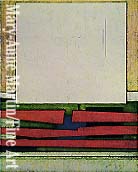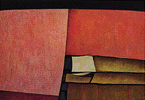
37. Manantial, 1993
|
As a work
method, Gerzso elaborates fine sketches on bond paper. He has a thorough
archive of all the drawing studies he has done for each painting. From a loose
sketch, he sets about establishing a geometrical scheme. He determines
points of intersection of lines by use of the golden mean. "I used to ruin
canvases; I read that Mr. da Vinci also did several preparatory drawings, to
the point that when the drawings were finished he was no longer interested
in the painting. Those are the true battlefields. I envy Mr. Picasso, who would
begin a painting just to see what came from it, and if it turned out, then
fine. But my style is like flying an airplane; you
cannot improvise."
Gunther registers every work session in a folder; which
pigments he has used, how many layers he has put down, what oil, which
varnish, and the date.
For Gerzso, painting is learned by looking. He has spent
days in the Louvre differentiating Titian from Tintoretto. "A painting is not
only the theme but the substance, the way it has been painted. Venus and
Adonis six feet away, but also at twelve inches. My uncle told me I had to
observe until the artist's very soul had entered me.
"I admire Morandi, who
takes a bottle and paints it. When I see Bonnard's wife, having a cup of tea
with her dog and cherries, I find it marvelous. A painting must be brought to
a point where it communicates the emotion that informed it. Then it
detaches itself from that emotion and acquires its own life. That is when
spirit inhabits matter. A painting isn't always achieved because it does not
always reach that point. I see paintings as patients. We are the doctors who
try to save them"
In Gerzso's life, everyday routine has the same precision as
his painting. When he was in film he would wake up at five in the morning
and would not go to bed until ten at night. These days he wakes up at
six-thirty, starts reading at seven. At nine he has breakfast and sometimes
goes back to bed to finish a book. He showers, and goes up to his studio,
working until two. He has lunch and half an hour later goes to his room to
read Newsweek or The New York Times Book Review, The London Book
Review, or a catalogue if it has arrived in the mail. He devours essays,
histories of art, biographies, novels, poetry.
What happens after painting,
family, and books?
"Nothing happens because there is nothing more. I watch
television, starting with the news, but I am not really interested in what I
am seeing.
It helps me concentrate, and ideas develop for the next day. Television is
just an instrument. I can't concentrate in silence. I am fascinated by this
procedure, this new use for television. Where, from the screen filled with
realistic, boring, and tacky images, ideas for a sketch are born. In the same
way, when I'm listening to music I concentrate on the CD's cover or on the
booklet. I read and listen, listen and read."











